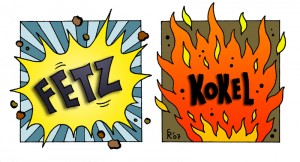The first question to ask here is: What is onomatopoeia? I am sure that everyone has heard. To me it is best known from my childhood, for example from Batman movies: bam, smack, pow, crunch. The longer I think about it, the more examples come to mind, for instance in pop art, internet forums, different comic books such as Donald Duck or even in songs. Have you heard of papa-oom-mow-mow from the Rivingtons? Hence, onomatopoeia is the imitation of natural sounds. You might wonder that all those common examples can be found in a newer period of time, and so do I. So where does onomatopoeia come from?
Onomatopoeia can be found in a lot of different fields. It is very widespread in the aforementioned comic speech, as a rather new development, or in child’s speech, especially when it comes to animal sounds. Comic speech often uses onomatopoeia, for instance sigh, clap, squeak, but those are rather classified as a subgroup, which find their origin themselves in onomatopoeia. However, animal sounds had ever since a great influence on the onomatopoeic word formation. Here it is interesting to note, that this process is relatively independent of the language, for instance the cockcrow is in English cock-a-doodle-doo, in Spanish quiquiriqui and in German kikeriki.
In literature, onomatopoeias are used as stylisic devices, such as metaphors. They emphasize parts or intensify certain expressions, such as the alliteration. Therefore, not only single onomatopoeias are used, but connections of several words and even other stylistic devices are employed. An example for this is a verse by Ovid, where he emphasizes the croaking of frogs: quamvis sint sub aqua, sub aqua maledicere temptant. Even without translation one can imagine the sound, frogs make.
There are even more traces for onomatopoeia that reach even far more back in time so the question remains: Where lies the true origin of onomatopoeia? Did a man in primitive times, when seeing an animal, imitate the sound of that animal in a way so that it, centuries after him, became an expression that we use today? And furthermore: How was it possible to associate that sound of nature with an articulated sound?
Stefan Kuhn
Read more:
- Karl Buehler: Sprachtheorie: die Darstellungsfunktion der Sprache, Fischer, Jena 1934.
- Onomatopoeie der Betonung, Friedrich Mauthner.
- Onomatopoeie der Etymologie, Friedrich Mauthner.
